
– Bringing Geography and Geo Survey to Life –
A group of key worker children in a primary school in Manchester spent a week exploring the world of underground survey and utility systems. Starting with the Get Kids into Survey Utilities Exploration Poster, the pupils expanded their geo survey knowledge, as well as their understanding of how the utilities that they depend on every day work, where they are located, how they are maintained, and what might happen if a strange and slippery creature found its way into the sewers…
Introducing the Project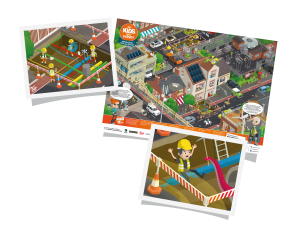
Following their work on mining, forestry and offshore survey, the group were already adept at spotting the geo survey activity and technology in the Utilities Exploration Poster. They identified the mobile scanning systems and the various LiDAR scanners, as well as the GPR unit – which led them to the focus of the project. The group discussed the utilities work taking place around the scene, focusing on the challenges of maintaining such a complex and potentially dangerous system, most of which is buried underground. Having also spotted the clumsy alien, the GeoSquad team, the shifty government agents, and even their own teacher in the poster, the group focused in on grid reference (D,5), where they made an alarming discovery…
Creature Research
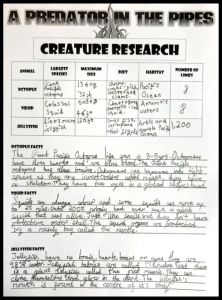 The long limb looming from the sewer pipe set the group’s imaginations racing – especially when they heard reports that one of the utilities workers had been pulled into the pipeline and had disappeared, along with any trace of the mysterious creature.
The long limb looming from the sewer pipe set the group’s imaginations racing – especially when they heard reports that one of the utilities workers had been pulled into the pipeline and had disappeared, along with any trace of the mysterious creature.
The pupils were set a challenge: use their geo survey knowledge to prepare and mount a rescue mission. They would have to find a way to navigate and check the utilities systems, then devise a means by which they could extract the creature and the worker safely. To do this, they’d first have to figure out exactly what they were dealing with.
The group selected three species of animal that they thought might be the possible owner of the alarming appendage from the poster. In order to know how to best deal with any possibility, they found out the maximum size of the biggest variety of each species, as well as its preferred habitat and diet. They also compiled a bank of other useful information, which they would use to inform their rescue tactics later in the project.
Sound it Out
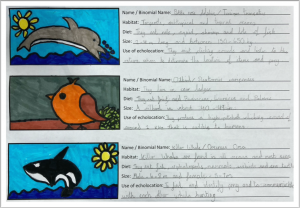 Having completed their creature research, the group turned their attention to a different set of interesting animals: those that use echolocation.
Having completed their creature research, the group turned their attention to a different set of interesting animals: those that use echolocation.
After identifying the GPR (Ground Penetrating Radar) device being used to scan beneath the ground around the utilities dig site in the exploration poster, the group were tasked to find three different animals that used sound to help them find their way, and often find their prey! Through this, they widened their understanding of how echolocation works in animals, and how humans integrated the same concept into machines that make it possible to ‘see’ using sound – particularly useful when you need to check underground pipes without having to tear up all the roads! As a result of this exercise, the group realised that GPR technology would be extremely useful in their mission to locate the missing worker and the slippery creature.
Stay Colour Coordinated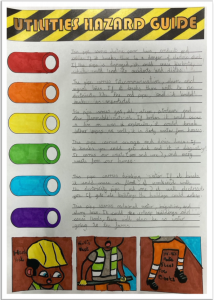
While exploring the utilities poster, the group also noticed something about the pipes: the various colours used for the criss-crossing conduits seemed significant. And they were right, of course – the colours of the underground pipes related directly to what they contained. The group was challenged to find out which colour linked to which contents, and to use this knowledge to prepare a safety guide for their dig team, including the potential hazards that would be caused by a breach of each utility line.
The group decided to include a guide to appropriate safety gear for their rescue team too!
Bait Your Trap
At this point in the project, the group received some good news, and some not-so-good news! The good news was that – thanks to their safety guide and sonar work – their rescue team had managed to locate the creature and the missing worker at a specific utility intersection. The not-so-good news came in the form of a phone call from the local aquarium, informing them that their resident giant Pacific octopus had escaped. From their early research, the group knew that this was the largest species of octopus in the world! Thankfully, they also knew all about its preferred habitat, diet and physiology, so when it came to designing a trap to catch this slippery cephalopod, they were already well prepared.
They began by creating rough sketches of their own individual solution to baiting a trap and catching the octopus:

One by one, the group gave an oral presentation on the design and function of their trap plan. Ideas included telescopic legs to lower and raise the trap to fit perfectly onto the sewer pipe, a water tank on top containing water that best suited the giant Pacific octopus, stretchy bands that would entangle the animal to prevent its escape, and video monitors to allow the team to keep an eye on the slippery escapee during transit. The group discussed which aspects of each offering they thought would be most effective, then combined them into a final group design using perspective drawing and 3D computer modelling:
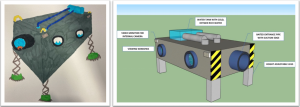
Having used the knowledge garnered across the project to create the ideal solution to the initial problem, the group dramatised the trip back to the aquarium with ‘Long-Arm Larry’ the giant Pacific octopus in tow – made slightly more problematic by a final spanner in the works: a blackout caused by a utility worker mishap!
The group found this project engaging and exciting from the outset, particularly since it gave them a greater awareness and appreciation of things that they had understandably taken for granted: the gas that fuels their cooker, the electricity powering their TVs, and even the waste water that leaves their toilets and sinks! Once again, the Get Kids into Survey learning resources succeeded in bringing practical geography to life.
Report compiled by Mathew Sullivan, FRSA Teacher, Author and Educational Consultant
Direct Links:
A Predator in the Pipes Lesson Plan and Worksheets

